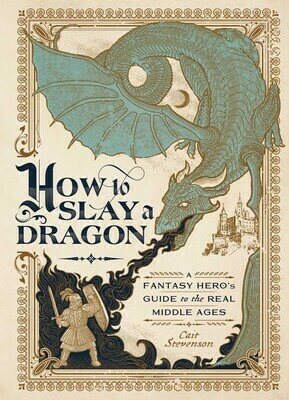From the Medieval Research Blog: "How to Slay a Dragon (and Reach a Public Audience)"

We are excited to congratulate Cait Stevenson (Ph.D '19), long-time blogger for the Medieval Institute Research Blog, on the publication of her book How to Slay a Dragon: A Fantasy Hero's Guide to the Real Middle Ages and on her stellar work at the crossroads of academic and public history. She recently wrote a blog for us about this new publication and what the writing process is like:
"If you ever fall asleep and wake up in a strange fantasy world, there is no reason to panic. Even if you have never rolled a d20 or published an article on Tolkien, you probably know you will be meeting your traveling party at an inn, dealing with a dragon or two, and feasting like it’s 1480 and you plan to commission a 124-folio illuminated manuscript account of your wedding that will also be printed for distribution to a wide public readership. You know these things because a facsimile of the Middle Ages has been host to wizards, jinn, and paladins since Lord of Rings, since Gothic fiction, since 1000 Nights became 1001. And now you can know that medieval history holds all the answers you need to survive and triumph in a five-volume fantasy trilogy.
At least, this is the premise of my new book, How to Slay a Dragon: A Fantasy Hero’s Guide to the Real Middle Ages (Tiller Press, 2001). It is a handbook for heroes that uses fantasy tropes as allegory to teach medieval history–and a little bit about critical interpretation of sources along the way. Throughout the book, you take on the role of an illiterate peasant (a Chosen One?) called to a quest (slaying a dragon, saving the princess, figuring out what to do while the princess saves herself), and every chapter presents a common trope–the more magical, the better–as a problem to solve.
Befriending the Enchanted Forest might not be possible because enchanted forests do not exist, but Muslim and Christian rulers alike showed off their power and riches with silver forests filled with golden chirping automatons. Medieval patterns of evangelization and conversion demonstrate the exact opposite of Bringing the Old Gods Back, but the Sphinx guarded the desert outside the Fatimid capital, and Abu Ja’far al-Idrisi (d. 1251) wanted to know why. (Caliphs were more interested in staging races up the Great Pyramid and throwing torchlit parties at Giza.) If you have ever needed to survive some shrieking eels or use linguistic evidence to reconstruct Early English beacon warning systems, How to Slay a Dragon is the book for you.
From the standpoint of writing the book, on the other hand, one of the big advantages of working with an editor and sales team at a major publishing house was to see what did and did not appeal to them along the way. The ideas seem basic, especially from a classroom point of view, but the publishers’ explicit acknowledgment of them suggests both their necessity and a feeling that they are lacking in the overall public discourse on the Middle Ages. [...]"
This is an excerpt from How to Slay a Dragon (and Reach a Public Audience) written by Cait Stevenson (Ph.D '19). Read the full story.